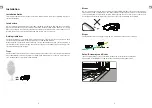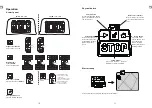
2
3
GB
GB
Installation
Installation Guide
This chapter explains how to install the Robotic Mower. Please read this completely before you
start the installation.
Introduction
We recommend creating a draft of your lawn, including all obstacles and how these should be
protected. This makes it easier to find a good position for the docking station and how to correctly
place the boundary wire around your garden perimeter protecting bushes, flower beds etc. You
will also need some tools, like a hammer and wire cutters, pliers or scissors.
Cutting limitations
The Robotic Mower is equipped with collision sensors. These will detect any rigid and fixed
obstacles higher than 100 mm, such as walls, fences and garden furniture.
When triggered, the Robotic Mower will stop, reverse backwards and then continue mowing in
a different direction. Still, protecting the obstacles running the boundary wire accordingly is the
recommended long-term solution.
Trees
The Robotic Mower treats trees as common obstacles, but if the roots of the tree are exposed and
lower than 100mm, this area should be excluded using boundary wire in order to protect the tree
root, cutting blades or rear wheels from damage.
Stones
We recommend clearing the lawn of small (less than 100 mm high) rocks and stones and any
stones with a round or sloped edge. The Robotic Mower might try and climb such rocks instead
of recognising them as a barrier. A Robotic Mower getting stuck on such a stone requires user
intervention to restart mowing. Contact with stones can result in damage to the blades.
Slopes
The Robotic Mower can navigate slopes up to a maximum of 30% incline or decline.
<
30%
>
30%
Paths, Driveways and Roads
If an elevated driveway crosses your lawn, better keep it outside the boundary wire.
Please allow a safety distance of 40 cm between driveway and boundary wire.
40cm
































